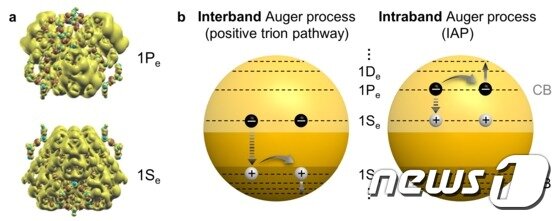 |
| Orbital electron distribution shape and intraband augmentation due to electron collision (Credit: IBS)© News1 |
The research team at the Research Institute of Basic Science (hereinafter referred to as IBS), head of the Molecular Spectroscopy and Dynamics Research Group (Professor of the Department of Chemistry, Korea University) discovered a new factor that hinders the performance of semiconductors using quantum dots.
According to IBS on the 3rd, a quantum dot is a semiconductor particle with a diameter of only 2 to 10 nm (nanometer, 1 billionth of a meter).
It has unique electrical and optical properties, such as emitting light of different frequencies depending on its size.
The core of quantum dot technology depends on the path through which electrons excited by the conduction band recombine with holes.
So far, many spectroscopy studies have been conducted to determine the motion of excited electrons.
However, in previous studies, it was difficult to clearly observe the complex electron transfer (changing the energy level of an electron) due to the effect of holes generated in the valence band.
Also, the existing technology had limitations in observing the dynamics of electrons in real time.
The researchers used’femtosecond time-resolved spectroscopy’ that can analyze samples in units of 100 femtoseconds (fs·1000 trillionths of a second). I succeeded in observing.
Self-doped quantum dots are particles in which a part of the conduction band is filled with electrons, and it is advantageous to selectively observe the movement of electrons inside the conduction band without the effect of holes in the valence band.
As a result, we discovered a new phenomenon in which electrons and holes recombine within about 1 picosecond (ps‧1 trillionth of a second) and named it the’intraband Auger process’.
This is a new phenomenon that could not be observed with existing technologies.
In the existing Auger phenomenon, the holes in the valence band played a major role in energy transfer.
On the other hand, the observed intraband augmentation phenomenon occurs based on collisions and energy transfer between electrons in the conduction band.
“As a result of selectively observing only electron transitions within the conduction band, we were able to find another factor that degrades the performance of quantum dot technology,” said Cho Min-haeng. said.
The research results were published in the online edition of’Matter’, a sister magazine of’Cell’, on January 30th.
